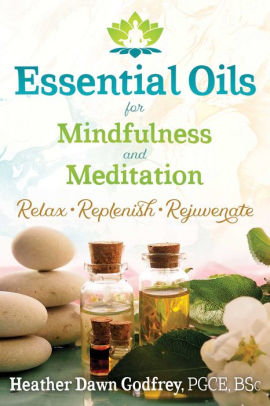Godfrey defines mindfulness as "a state of consciously being aware, of paying attention to and maintaining concentration on in consciousness of the Here and Now" pg 11. Mindfulness stems from Buddhist beliefs but is not meant to be religious though there is a spiritual aspect to it. Godfrey provides research evidence to support her ideas and concepts. In addition to presenting her ideas and the support she gets through research, she discusses personal experiences in order to help the reader better relate to the concept she's representing. The author talks about how to get started with mindful meditation. This includes an initial premeditation mindfulness focus and sitting in meditation. Then she moves into essential oils as meditation companions.
She gives appropriate warnings when it comes to things like ingesting essential oils. She reiterates this throughout the book. It illustrates her responsible attitude towards the use of essential oils. Additionally she encourages people to try the oils through patch testing. This is applying the oil too small part of your skin to determine whether it has a negative effect or not. She very clearly outlines when a patch test should be done as well as how to do it. Additionally she gives limitations on how much essential oil should be used within a 24-hour period of time. The use of color pictures enhances the overall layout of the book. The pictures she chooses represent the concept she's trying to discuss. Additionally she has a good use of graphics and tables intermixed with the text to keep the book moving along.
She uses tables to summarize data. They appear to be well organized and language most people could understand. She uses color coordinating to the relate information from one table to the next. They're well-organized and thorough. She compares the sense of smell with brain activity and how essential oils help or may help with certain aspects. She spends a chapter on complementary wellness techniques. In this chapter she includes nutritional information on how best to get certain vitamins when and how much protein you should have. She includes all the normal things you would get in this type of chapter.
At the beginning of chapter 2 she has a number of statements about what essential oils may be able to do. May is the important word because what works for one person does not necessarily work for another. She defines essential oils; however she uses no less than four adjectives which are bigger than they need to be. She stepped back and forth between technical and casual language which makes it difficult to read. She reuses phrases which gets a little tiresome. Some of her sentence structure is awkward and difficult to understand. In general though she writes in a mostly conversational tone with a hint of Academia. Her sentence structure is complex and convoluted in such a way that her sentences are exceedingly long and nearly in comprehensible. While the information she's presenting is accurate, the reader has to dig through academic style writing in some places to glean her meaning.
The information provided is thorough and is responsibly presented. However the writing style is complex and difficult. Overall, a good book with a lot of good information but not a simple or easy read.
~review by Eileen Troemel
Author: Heather Dawn Godfrey
Healing Arts Press, 2018
p. 146
Essential Oils for Mindfulness & Meditation: Relax, Replenish, and Rejuvenate

©
2010 - 2025
Facing North
